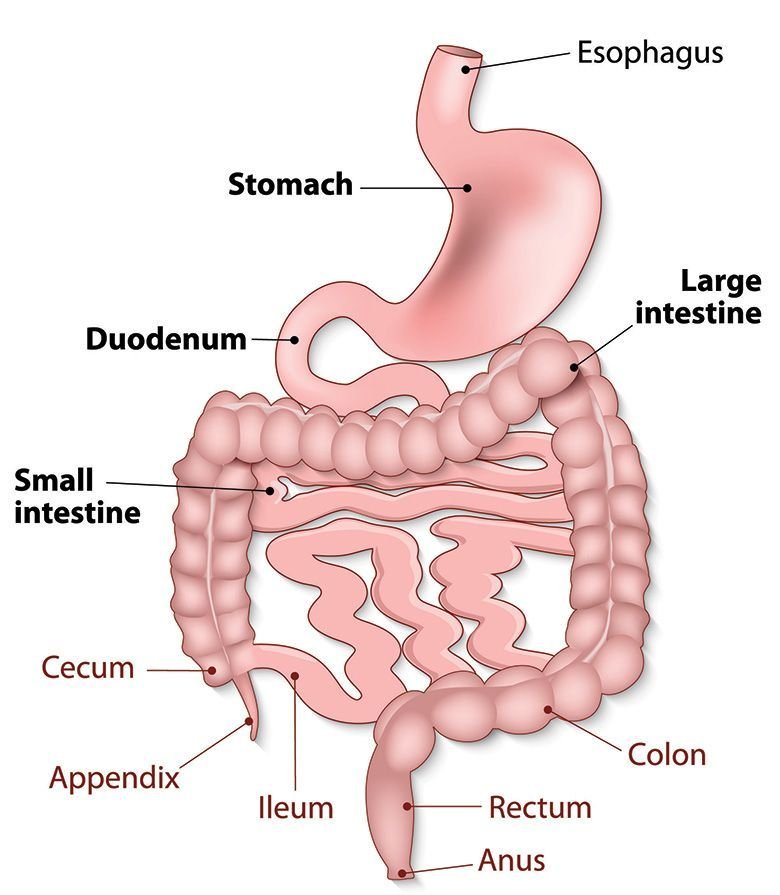Surprisingly, the longest section of the digestive system is the small intestine. Imagine it as a tightly twisted tube that spans around 7.5 meters. Despite its narrow appearance, the inside of this tube boasts a considerable surface area. This is where thorough digestion takes place in our bodies. The small intestine fully absorbs the nutrients from the digested food, and it also releases intestinal juice. Moreover, it gets contributions in the form of bile juice from the liver and pancreatic juice from the pancreas.
Parts of Small Intestine
The small intestine is divided into three parts:
- Duodenum
- Jejunum
- Ileum

Duodenum
- The first part of the small intestine is the Duodenum. It is a short and curved section, approximately 20–25 cm (8–10 in) in length, resembling a “C” shape. Picture it wrapping around the head of the pancreas.
- The duodenum plays host to gastric chyme from the stomach, teaming up with digestive juices from the pancreas (loaded with digestive enzymes) and the liver (supplying bile).
- These enzymes get to work breaking down proteins, while bile takes on the task of emulsifying fats into micelles.
- Brunner’s glands in the duodenum produce a mucus-rich alkaline secretion containing bicarbonate, which, combined with pancreatic bicarbonate, helps neutralize the stomach acids in the gastric chyme.
Jejunum
- Moving on to the jejunum, the middle segment of the small intestine, linking the duodenum to the ileum.
- Stretching approximately 2.5 meters (8 feet) long, it’s adorned with circular folds and intestinal villi that boost its surface area.
- This is the spot where the bloodstream eagerly absorbs the products of digestion—sugars, amino acids, and fatty acids.
- Keep an eye out for the suspensory muscle of the duodenum; it marks the boundary between the duodenum and the jejunum.
Ileum
- Lastly, we have the ileum, the grand finale of the small intestine, boasting a length of about 3 meters.
- Much like its jejunum counterpart, the ileum sports villi and is responsible for absorbing vitamin B12, bile acids, and any other lingering nutrients.
- The ileum makes its connection with the cecum of the large intestine at the ileocecal junction.
- Picture the jejunum and ileum suspended gracefully in the abdominal cavity by the mesentery, a vital part of the peritoneum. Within this mesentery network, arteries, veins, lymph vessels, and nerves travel, ensuring the intricate dance of nutrient absorption and bodily functions. Quite a dynamic spectacle, isn’t it?
Functions of the Small Intestine
Let’s crack the incredible functions of the small intestine, a powerhouse in our digestive system.
Complete Digestion of Food
- In the duodenum of the small intestine, a remarkable process unfolds as it absorbs partially digested food, joined by digestive juices from the liver, pancreas, and its own walls.
- The liver steps in with its bile juice, transforming fat into minuscule droplets, making their digestion a breeze. Meanwhile, the pancreas takes the stage, producing pancreatic juice that skillfully breaks down fats into fatty acids and glycerol.
- Adding to this digestive symphony, the walls of the small intestine contribute intestinal juice, breaking down starch and carbohydrates into simple sugars, or as we know them – glucose. Proteins don’t get left out either; they transform into amino acids.
Collectively, these simplified forms are what we call digested food.
Absorption of Digested Food
The small intestine doesn’t stop there; it’s also a champion in absorbing the digested food.
This absorption takes place through blood vessels in the intestine walls, with a crucial assist from the finger-like projections known as villi.
These villi play a starring role, dramatically increasing the surface area of the small intestine to ensure maximum absorption.
As the blood carries the absorbed nutrients throughout the body, glucose, a key player, undergoes a breakdown, releasing the energy essential for various life processes.
Final Journey
The small intestine, having done its job splendidly, guides the undigested and unabsorbed remnants of food to the large intestine. There, the final chapters of digestion unfold, marking the end of the line for what the body doesn’t need.
In essence, the small intestine takes center stage in the grand performance of digestion, ensuring that the body receives the nutrients it craves while efficiently managing the leftovers. Quite a digestive maestro, isn’t it?
More Topics on Biology:
Heart Chambers: Anatomy, Functions, Diagram & Exam-Focused Notes
Vitamin Deficiency Diseases – Causes, Symptoms, Sources & Exam-Focused Notes
Function of the Stomach in the Human Body: Key Roles, Mechanisms & Importance
Composition of Lymph Fluid: Definition, Components, and Functions Explained
Composition of Serum: Components, Functions & Clinical Importance
Salivary Glands: Structure, Functions, and Clinical Importance
Zygote: Definition, Formation, Timeline, Totipotency, and Role in Human Development

